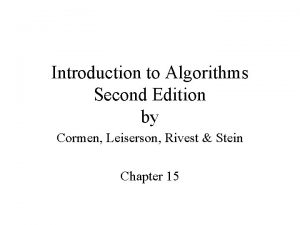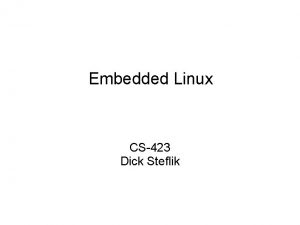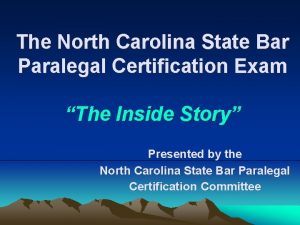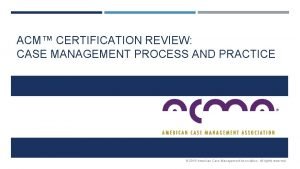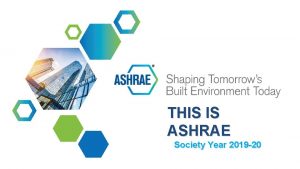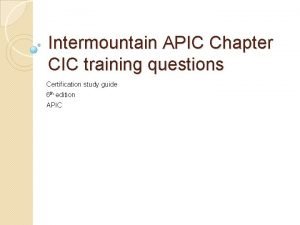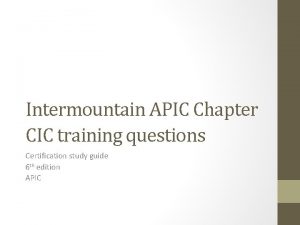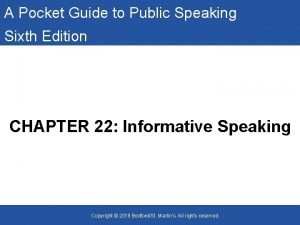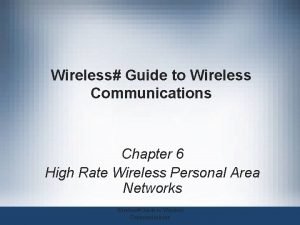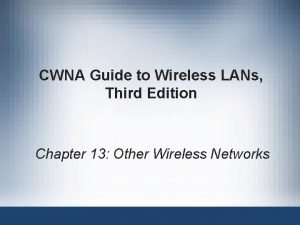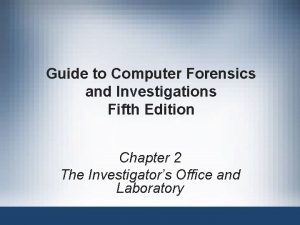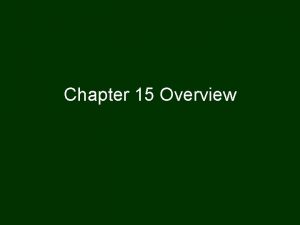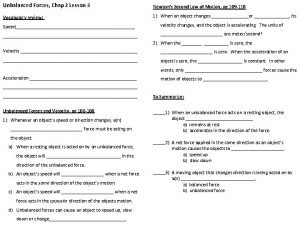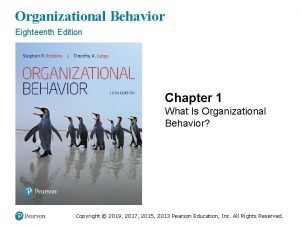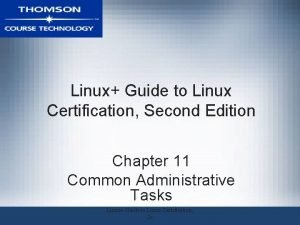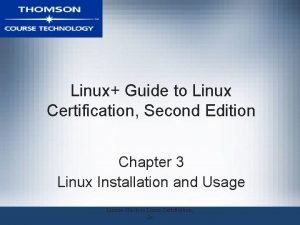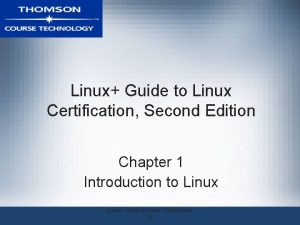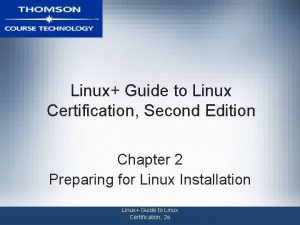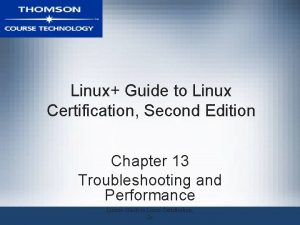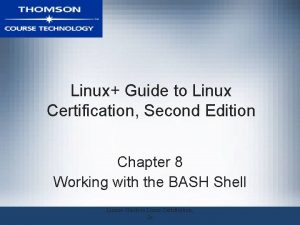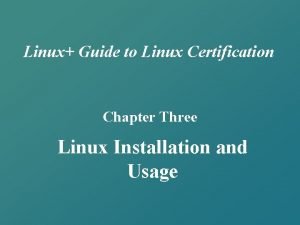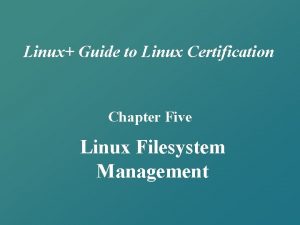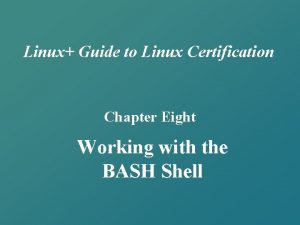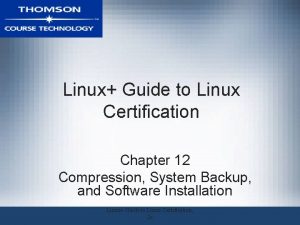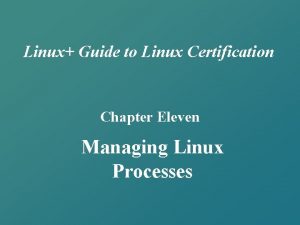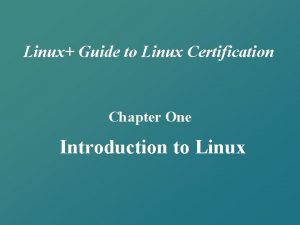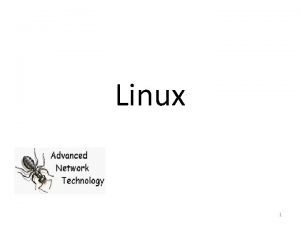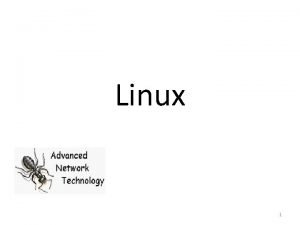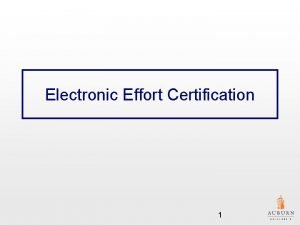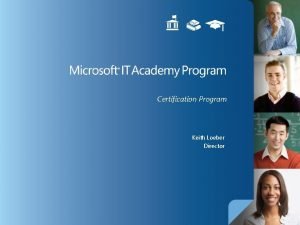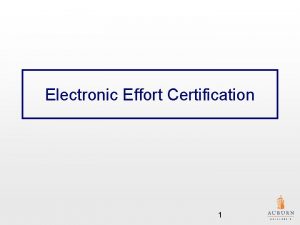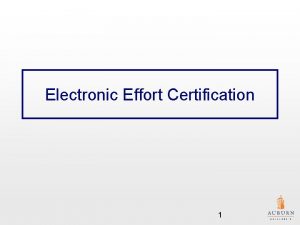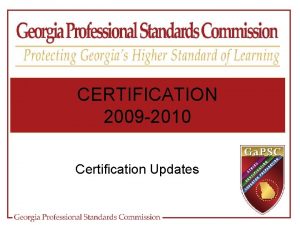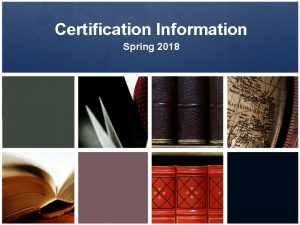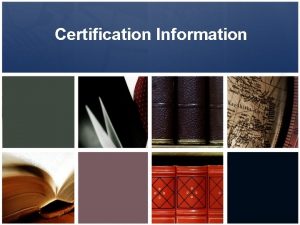Linux Guide to Linux Certification Second Edition Chapter













































- Slides: 45

Linux+ Guide to Linux Certification, Second Edition Chapter 14 Network Configuration Linux+ Guide to Linux Certification, 2 e

Objectives • Describe the purpose and types of networks, protocols, and media access methods • Understand the basic configuration of TCP/IP • Configure a NIC interface to use TCP/IP Linux+ Guide to Linux Certification, 2 e 2

Objectives (continued) • Configure a modem, ISDN, and DSL interface to use PPP and TCP/IP • Understand the purpose of host names and how they are resolved to IP addresses • Use common network utilities to interact with network services Linux+ Guide to Linux Certification, 2 e 3

Networks and TCP/IP • Network: Two or more computers joined via network media and able to exchange information • Local Area Networks (LANs): Computers within close proximity • Wide Area Networks (WANs): Computers separated by large distances • Internet service provider (ISP): Company providing internet access Linux+ Guide to Linux Certification, 2 e 4

Networks and TCP/IP (continued) • Routers: Devices capable of transferring packets between networks • Protocols: Set of rules for communication between networked computers • Packets: Packages of data formatted by a network protocol • Media access method: Defines how networked computers share access to the physical medium Linux+ Guide to Linux Certification, 2 e 5

Networks and TCP/IP (continued) • Linux network protocols: – TCP/IP (Transfer Control Protocol/Internet Protocol) – UDP/IP (User Datagram Protocol/Internet Protocol) – IPX/SPX (Internetwork Packet Exchange/Sequence Packet Exchange) – Appletalk – DLC (Data Link Control) – DECnet (Digital Equipment Corporation network) Linux+ Guide to Linux Certification, 2 e 6

Networks and TCP/IP (continued) • Ethernet: Most common network media access method • Token Ring: Popular media access method • Media access method usually contained on NIC or modem hardware Linux+ Guide to Linux Certification, 2 e 7

The TCP/IP Protocol: IP Addresses • IP address: Unique number that identifies a networked computer – Octets: Series of four 8 -bit numbers • Unicast: Directed TCP/IP communication between two computers Linux+ Guide to Linux Certification, 2 e 8

The TCP/IP Protocol: IP Addresses (continued) • IP addresses composed of two parts: – Network ID: Network computer is located on – Host ID: Single computer on that network • Cannot have two computers with same host ID on a network • Only computers with same network ID can communicate without a router Linux+ Guide to Linux Certification, 2 e 9

Subnet Masks • Define which part of IP address is the network ID and which part is the host ID – Series of four 8 -bit numbers • ANDing: Calculate network and host IDs from an IP address and subnet mask – Compare binary bits Linux+ Guide to Linux Certification, 2 e 10

Subnet Masks (continued) Figure 14 -1: A sample IP address and subnet mask Linux+ Guide to Linux Certification, 2 e 11

Subnet Masks (continued) • 0. 0 = all networks • 255 = all computers • 255 in an IP address can specify many hosts – Broadcast addresses Linux+ Guide to Linux Certification, 2 e 12

Default Gateway • IP address on router that sends packets to remote networks • Routers can distinguish between different networks – Move packets between them – Have assigned IP addresses on each attached network Linux+ Guide to Linux Certification, 2 e 13

TCP/IP Classes and Subnetting • IP address class defines default subnet mask of associated device • Multicast: TCP/IP communication destined for a certain group of computers – Class D addresses • Subnetting: Divide a large network into smaller networks – Control traffic flow – Take bits from host ID, give to network ID Linux+ Guide to Linux Certification, 2 e 14

TCP/IP Classes and Subnetting (continued) Table 14 -1: IP address classes Linux+ Guide to Linux Certification, 2 e 15

Configuring a NIC Interface • ifconfig command: Assign TCP/IP configuration to a NIC – Also used to view configuration of all network interfaces in computer • dhclient command: Receive TCP/IP configuration from DHCP or Boot Protocol (BOOTP) server Linux+ Guide to Linux Certification, 2 e 16

Configuring a NIC Interface (continued) • /etc/sysconfig/network-scripts/ifcfg-<interface> file: Stores NIC configurations • Packet internet groper (ping) command: Check TCP/IP connectivity on a network Linux+ Guide to Linux Certification, 2 e 17

Configuring a NIC Interface (continued) Figure 14 -2: Configuring network interfaces Linux+ Guide to Linux Certification, 2 e 18

Configuring a NIC Interface (continued) Figure 14 -3: Configuring TCP/IP information for a network interface Linux+ Guide to Linux Certification, 2 e 19

Configuring a PPP Interface • Run TCP/IP over serial lines – Use a WAN protocol • Three common Point-to-Point Protocol (PPP) technologies: – Modems – ISDN – DSL Linux+ Guide to Linux Certification, 2 e 20

Configuring a PPP Interface (continued) Figure 14 -4: Adding a network interface Linux+ Guide to Linux Certification, 2 e 21

Configuring a PPP Interface (continued) Figure 14 -5: Selecting modem hardware Linux+ Guide to Linux Certification, 2 e 22

Configuring a PPP Interface (continued) Figure 14 -6: Selecting ISDN hardware Linux+ Guide to Linux Certification, 2 e 23

Configuring a PPP Interface (continued) Figure 14 -7: Specifying ISP settings Linux+ Guide to Linux Certification, 2 e 24

Configuring a PPP Interface (continued) • Information about PPP devices stored in files named ifcfg-<Internet. Service. Provider. Name> – /etc/sysconfig/network-scripts directory • Other configurations used by PPP daemon stored in /etc/ppp and /etc/isdn Linux+ Guide to Linux Certification, 2 e 25

Configuring a PPP Interface (continued) Figure 14 -8: Specifying TCP/IP settings Linux+ Guide to Linux Certification, 2 e 26

Configuring a PPP Interface (continued) Figure 14 -9: Configuring an x. DSL connection Linux+ Guide to Linux Certification, 2 e 27

Configuring a PPP Interface (continued) Figure 14 -10: Activating a PPP connection Linux+ Guide to Linux Certification, 2 e 28

Name Resolution • • Hostnames: User-friendly computer name FQDN: Hostname following DNS convention DNS: Hierarchical namespace for host names hostname command: View or set a computer’s host name Linux+ Guide to Linux Certification, 2 e 29

Name Resolution (continued) Figure 14 -11: The Domain Name Space Linux+ Guide to Linux Certification, 2 e 30

Name Resolution (continued) • TCP/IP cannot identify computers via hostnames – Must map hostnames to IP addresses – Entries in /etc/hosts file • ISPs list FQDNs in DNS servers on Internet – Applications request IP addresses associated with FQDN Linux+ Guide to Linux Certification, 2 e 31

Connecting to Network Resources • Network resources: – Shared printers – Applications – Files • To use network resources, must have appropriate network utilities Linux+ Guide to Linux Certification, 2 e 32

Downloading Files Using FTP • Most web browsers have built-in FTP utility • FTP utility: Downloads files from FTP servers Linux+ Guide to Linux Certification, 2 e 33

Downloading Files Using FTP (continued) Figure 14 -12: Using a Web browser FTP client Linux+ Guide to Linux Certification, 2 e 34

Downloading Files Using FTP (continued) Table 14 -2: Common FTP commands Linux+ Guide to Linux Certification, 2 e 35

Downloading Files Using FTP (continued) Table 14 -2 (continued): Common FTP commands Linux+ Guide to Linux Certification, 2 e 36

Accessing Files with NFS • NFS: Common method for file transfer between UNIX and Linux computers – Not as common as FTP – Mount directory from a remote computer Linux+ Guide to Linux Certification, 2 e 37

Accessing Windows Files • Mount shared Windows directory to local directory – Filesystem must be smbfs • smbmount command: Mount directories from Windows computers • smbclient utility: Connect to shares on a Windows system • umount command: Unmount Windows directories Linux+ Guide to Linux Certification, 2 e 38

Running Remote Applications • Access to BASH shell may be obtained by connecting to a server across a network • telnet utility: Most common utility used to obtain BASH shell over a network – No encryption • Secure Shell (ssh) utility: Uses encryption Linux+ Guide to Linux Certification, 2 e 39

Running Remote Applications (continued) • rlogin: Obtain a shell from remote computer on network • “r” utilities allow access to remote computers without a password • Trusted access: Computers allowed to access a computer without providing a password Linux+ Guide to Linux Certification, 2 e 40

Accessing E-mail • Post Office Protocol (POP): Download e-mail messages from e-mail server • Internet Message Access Protocol (IMAP): View email messages across network • Simple Mail Transfer Protocol (SMTP): Sending mail from MUA to e-mail server – Mozilla Mail is most common MUA for Linux+ Guide to Linux Certification, 2 e 41

Accessing E-mail (continued) Figure 14 -13: Configuring a mail account in Mozilla Mail Linux+ Guide to Linux Certification, 2 e 42

Accessing E-mail (continued) Figure 14 -14: Using Mozilla Mail Linux+ Guide to Linux Certification, 2 e 43

Accessing E-mail (continued) • Linux systems typically use an internal mail system designed for administration – Daemons e-mail root user when important events or problems occur • mail utility: Basic e-mail reader available on most Linux distributions • mutt utility: Popular MUA – Can run in a terminal Linux+ Guide to Linux Certification, 2 e 44

Accessing E-mail (continued) Figure 14 -15: The mutt mail user agent Linux+ Guide to Linux Certification, 2 e 45
 27 miles per gallon into kilometers per liter
27 miles per gallon into kilometers per liter Advanced word power second edition answers
Advanced word power second edition answers Accounting principles second canadian edition
Accounting principles second canadian edition Accounting principles second canadian edition
Accounting principles second canadian edition Accounting principles second canadian edition
Accounting principles second canadian edition Clear thinking and writing
Clear thinking and writing Accounting principles second canadian edition
Accounting principles second canadian edition Kaufman tamine
Kaufman tamine Introduction to algorithms 2nd ed
Introduction to algorithms 2nd ed In company second edition
In company second edition Wechsler individual achievement test second edition
Wechsler individual achievement test second edition Ten steps to advanced reading 2nd edition answers
Ten steps to advanced reading 2nd edition answers Organic chemistry
Organic chemistry Using mis (10th edition) 10th edition
Using mis (10th edition) 10th edition Mis
Mis Kernel linux security module m1 support
Kernel linux security module m1 support Guilots
Guilots Nc state bar paralegal search
Nc state bar paralegal search Acm certification pass rate
Acm certification pass rate Certification study guide: certified hvac designer (chd)
Certification study guide: certified hvac designer (chd) Apic cic study guide
Apic cic study guide Apic certification study guide
Apic certification study guide Florida real estate broker's guide
Florida real estate broker's guide Florida real estate broker's guide
Florida real estate broker's guide Pocket guide to public speaking
Pocket guide to public speaking Guide to wireless communications
Guide to wireless communications Guide to computer forensics and investigations 6th edition
Guide to computer forensics and investigations 6th edition Prehospital emergency care 11th edition study guide
Prehospital emergency care 11th edition study guide The no brokerage relationship notice must be disclosed
The no brokerage relationship notice must be disclosed Florida real estate broker's guide 6th edition
Florida real estate broker's guide 6th edition Cwna guide to wireless lans 3rd edition
Cwna guide to wireless lans 3rd edition Guide to computer forensics and investigations 5th edition
Guide to computer forensics and investigations 5th edition Florida real estate broker's guide 6th edition
Florida real estate broker's guide 6th edition A pocket guide to public speaking 6th edition
A pocket guide to public speaking 6th edition A pocket guide to public speaking 6th edition
A pocket guide to public speaking 6th edition Dk guide to public speaking 2nd edition
Dk guide to public speaking 2nd edition Florida real estate broker's guide 6th edition
Florida real estate broker's guide 6th edition Florida real estate broker's guide
Florida real estate broker's guide Florida real estate broker's guide 6th edition
Florida real estate broker's guide 6th edition Chapter 2 automotive careers and ase certification
Chapter 2 automotive careers and ase certification Chapter 15 section 2
Chapter 15 section 2 Second great awakening apush chapter 15
Second great awakening apush chapter 15 Chapter 2 lesson 3 newton's second law
Chapter 2 lesson 3 newton's second law Organizational behavior chapter 1 summary
Organizational behavior chapter 1 summary Organic chemistry (3rd) edition chapter 1 problem 16s
Organic chemistry (3rd) edition chapter 1 problem 16s Ferdinand beer
Ferdinand beer








